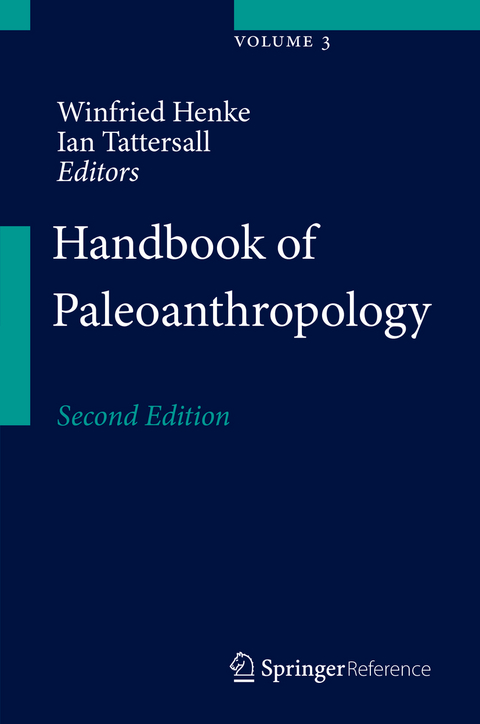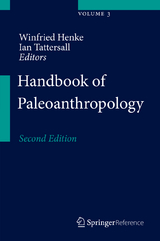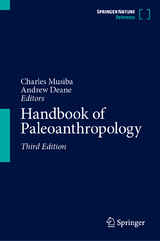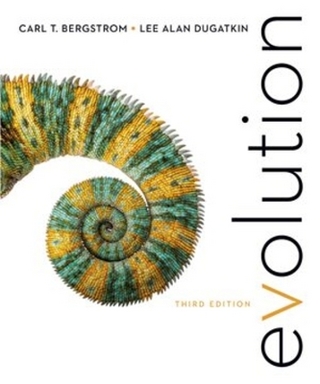Handbook of Paleoanthropology
Springer Berlin
978-3-642-39978-7 (ISBN)
This extensive, three-volume handbook, intensively updated and enlarged, is a superb new resource for students, researchers, and practitioners in paleoanthropology. A baseline storehouse covering the full extent of current knowledge, the volume features an online e-reference work that will be updated with future developments in this fascinating discipline. Often cited as the most multidisciplinary of all the sciences, paleoanthropology encompasses a vast range of techniques drawn from geology, evolutionary biology, and archaeology, among many others.
Guided by an editorial team of global stature, the contributions reflect the best of today's scholarship. Each volume covers core constituents of the subject: basic principles and methods, primate evolution and human origins, and the phylogeny of hominins. The editors have ensured that the entries uphold a key principle of paleoanthropology, requiring historical assessments to be updated with developing knowledge of the living world.
The handbook's first volume incorporates the enormous advances made in such areas as phylogenetic analysis, paleoecology and evolutionary theory and philosophy. Volume II integrates primate fossil data with the vast amount that is now known of the behavior and ecology of living primates in natural environments. The third volume deals with the fossil and molecular evidence for the evolution of Homo sapiens and its fossil relatives. Paleoanthropology is characterized by its many live and unresolved academic debates, which are reflected in the heterogeneity of intellectual standpoints in this handbook. This planned diversity ensures that the Springer Handbook of Paleoanthropology is a multilayered, comprehensive companion of inestimable value to students, academics, and working professionals alike.
Winfried Henke is retired Academic Director and apl. Professor of Anthropology at the Johannes Gutenberg University of Mainz. He was born in 1944 in Pomerania, Germany, and studied biology, anthropology, geosciences, as well as philosophy and pedagogy in Kiel and Braunschweig. In 1971, he received his Ph.D. (Dr. rer. nat.) from the University of Kiel, his thesis focusing on a prehistoric anthropological topic and multivariate statistical analysis in skeletal biology. Since 1971, Henke conducted research and taught at the Faculty of Biology of the Johannes Gutenberg University of Mainz in paleoanthropology, primatology, prehistoric anthropology, comparative morphology, systematics, demography, sociobiology, and scientific history. He had research activities in various countries (Iceland, Israel, Jordan, US, Greece), and in 1990, he habilitated with a monograph on the “Anthropology of Upper Paleolithics and Mesolithics of Europe and the Mediterranean Basin.” In the scope of the ERASMUS docent exchange program, intensive lecturing at numerous European Universities followed. Henke acted as elected anthropology referee for the German Research Foundation (DFG) and still serves at the advisory boards of scientific journals (e.g., Interdisziplinäre Anthropologie, published at Springer-Verlag); further, he was book review editor and advisory consultant to museums, e.g., the Neanderthal Museum (Germany). He published approximately 200 original papers in scientific journals and anthologies and several hundreds of book reviews and supervised more than 100 diplomas and Ph.D. theses in biological anthropology. He is author, coauthor (together with H. Rothe), and editor of several books including such standard works as Paläoanthropologie, Stammesgeschichte des Menschen, and Phylogenetische Systematik (published at Springer-Verlag). In 2006, he was awarded the honorary doctorate of the National and Kapodistrian University of Athens; he is an elected member of the German National Academy of Sciences Leopoldina and Academician of the Leibniz-Sozietaet of Sciences. Ian Tattersall is Curator Emeritus in the Division of Anthropology of the American Museum of Natural History in New York City. Trained in archaeology and anthropology at Cambridge and in geology and vertebrate paleontology at Yale, he has worked on lemur systematics and ecology as well as in paleoanthropology, where his special interest has been in hominid diversity and cognitive evolution. Most recently, he has been concerned with trying to understand how a nonlinguistic and nonsymbolic ancestor gave rise to the cognitively unprecedented Homo sapiens and what drove the exceptionally fast evolution of the human lineage over the course of the Pleistocene. He has done both primatological and paleontological fieldwork in countries as diverse as Madagascar, Vietnam, Surinam, Yemen, and Mauritius. In collaboration with Jeffrey Schwartz, he wrote three volumes of The Hominid Fossil Record (2002–2005), a documentation in standardized descriptive and illustrative format of a large proportion of the most significant fossils that tell the human evolutionary story. Ian is also a prominent interpreter of human paleontology to the public with several trade books to his credit, among them The Brain: Big Bangs, Behaviors, and Beliefs (2012, with Rob DeSalle), Masters of the Planet (2012), Race? Debunking a Scientific Myth (2011, with Rob DeSalle), The World from Beginnings to 4000 BCE (2008), Becoming Human: Evolution and Human Uniqueness (1998), and The Fossil Trail: How We Know What We Think We Know About Human Evolution (1995, 2nd ed. 2009), as well as many articles in Scientific American and Natural History and the coeditorship of the definitive Encyclopedia of Human Evolution and Prehistory. He lectures widely and, as curator, has also been responsible for several major exhibits at the American Museum of Natural History including Ancestors: Four Million Years of Humanity (1984); Dark Caves, Bright Visions: Life In Ice Age Europe (1986); Madagascar: Island of the Ancestors (1989); The First Europeans: Treasures from the Hills of Atapuerca (2003); and the highly acclaimed Hall of Human Biology and Evolution (1993) and its successor, Hall of Human Origins (2007).
Volume 1: Principles, Methods, and Approaches: Historical Overview of Paleoanthropological Research.- Charles Darwin, Paleoanthropology, and the Modern Synthesis (NEW).- Evolutionary Theory in Philosophical Focus.- The Ontogeny-Phylogeny Nexus in a Nutshell: Implications for Primatology and Paleoanthropology.- Principles of Taxonomy and Classification: Current Procedures for Naming and Classifying Organisms.- Species Concepts and Speciation: Facts and Fantasies.- Quantitative Approaches to Phylogenetics.- Homology: A Philosophical and Biological Perspective.- Chronometric Methods in Paleoanthropology.- Patterns of Diversification and Extinction.- Taphonomic and Diagenetic Processes.- Contribution of Stable Light Isotopes to Paleoenvironmental Reconstruction.- The Paleoclimatic Record and Plio-Pleistocene Paleoenvironments (NEW).- Geological Background of Hominid Sites in Africa.- Paleosols.- Quaternary Geology and Paleoenvironments (NEW).- Quaternary Deposits and Paleosites.- Paleoecology: An Adequate Window on the Past?.- Zoogeography: Primate and Early Hominin Distribution and Migration Patterns.- The Paleodemography of Extinct Hominin Populations.- Hominin Paleodiets: The Contribution of Stable Isotopes.- Estimation of Basic Life History Data of Fossil Hominoids.- Genetics and Paleoanthropology (NEW).- Ancient DNA .-Modeling the Past: The Primatological Approach.- Modeling the Past: The Paleoethnological Approach .-Modeling the Past: Archaeology.- The Evolution of Speech and Language (NEW).- General Principles of Evolutionary Morphology.- Virtual Anthropology and Biomechanics (NEW).- Paleopathology: Vestiges of Pathological Conditions in Fossil Human Bone (NEW).- Microscopic Research on Fossil Human Bone (NEW).- Investigation on Extracellular Matrix Proteins in Fossil Bone: Facts and Perspectives (NEW).- Images in Paleoanthropology: Facing Our Ancestors (NEW).- Prospects and Pitfalls.- Volume 2: Primate Evolution and Human Origins: Primate Origins and Supraordinal Relationships: Morphological Evidence.- Molecular Evidence of Primate Origins and Evolution (NEW).- Fossil Record of the Primates from the Paleocene to the Oligocene (NEW).- Fossil Record of Miocene Hominoids.- The Biotic Environments of the Late Miocene Hominids.- Postcranial and Locomotor Adaptations of Hominoids.- Hominoid Cranial Diversity and Adaptation.- Dental Adaptations of African Apes.- Evolution of the Primate Brain.- Primate Life Histories.- Great Ape Social Systems.- Evolutionary Biology of Ape and Monkey Feeding and Nutrition.- The Hunting Behavior and Carnivory of Wild Chimpanzees.- Cooperation, Coalition, and Alliances.- Primate Intelligence.- Theory of Mind: A Primatological Perspective (NEW).- Volume 3: Phylogeny of Hominins: Potential Hominoid Ancestors for Hominidae.- Defining Hominidae.- Role of Environmental Stimuli in Hominid Origins.- Origins of Homininae and Putative Selection Pressures Acting on the Early Hominins.- Origin of Bipedal Locomotion.- The Evolution of the Hominid Brain (NEW).- Analyzing Hominin Phylogeny: Cladistic Approach.- Phylogenetic Relationships of Hominids: Biomolecular Approach.- The Miocene Hominoids and the Earliest Putative Hominids.- The Species and Diversity of Australopiths.- Defining the Genus Homo.- The Earliest Putative Homo Fossils.- Homo ergaster and Its Contemporaries.- Defining Homo erectus (NEW).- Later Middle Pleistocene Homo.- Neanderthals and Their Contemporaries.- Homo floresiensis (NEW) .- Origin of Modern Humans.- Population Biology and Population Genetics of Pleistocene Hominins.- Dispersals of Early Humans: Adaptations, Frontiers, and New Territories (NEW).- Dentition of American Indians: Evolutionary Results and Demographic Implications Following Colonization from Siberia.- Overview of Paleolithic Archaeology.- Cultural Evolution During the Middle and Late Pleistocene in Africa and Eurasia.- Evolution of Religion (NEW).- Paleoanthropology and the Foundation of Ethics:
| Erscheint lt. Verlag | 26.1.2015 |
|---|---|
| Reihe/Serie | Handbook of Paleoichthyology ; 3 |
| Zusatzinfo | XLIII, 2624 p. 393 illus., 118 illus. in color. In 5 volumes, not available separately. |
| Verlagsort | Berlin |
| Sprache | englisch |
| Maße | 155 x 235 mm |
| Gewicht | 4608 g |
| Themenwelt | Naturwissenschaften ► Biologie ► Evolution |
| Naturwissenschaften ► Geowissenschaften ► Mineralogie / Paläontologie | |
| Sozialwissenschaften ► Ethnologie | |
| Schlagworte | Fossils and Molecular Biology • Human Evolution • Paleoanthropology • Primate Evolution |
| ISBN-10 | 3-642-39978-9 / 3642399789 |
| ISBN-13 | 978-3-642-39978-7 / 9783642399787 |
| Zustand | Neuware |
| Informationen gemäß Produktsicherheitsverordnung (GPSR) | |
| Haben Sie eine Frage zum Produkt? |
aus dem Bereich



